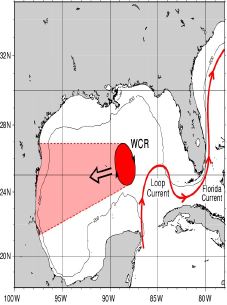
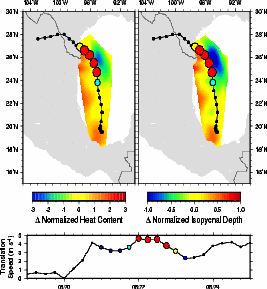
FIFTH INTERNATIONAL WORKSHOP ON TROPICAL CYCLONES
Topic 1.4 Air-Ocean Interface and Boundary Processes
Rapporteur: L. K. Shay
Division of Meteorology and Physical Oceanography
Rosenstiel School of Marine and Atmospheric Science
University of Miami
4600 Rickenbacker Causeway
Miami, FL 33149, USA
e-mail: nick@erg.rsmas.miami.edu
phone: 305-361-4075
fax: 305-361-4696
Working Group: P. G. Black, M. Banner, Y. Duan, K. Emanuel, J. Kepert, V. Pudov, E. Walsh
Abstract:
Significant progress has been made over the past four years since IWTC-4 in the interactions between the oceanic and atmospheric planetary boundary layers during the passage of a tropical cyclone (TC). This report attempts to document this recent progress from experimental, empirical, theoretical and numerical perspectives. Of particular importance here is to illustrate that the temporal and spatial scales of the air-sea interactions range from seconds to hours, and meters to 100’s of kilometers. Understanding these relevant scales is central to improving predictions of the processes, and hence their importance on TC intensity and structure change from a global perspective.
On the mesoscale, oceanic heat content is particularly important because it provides an estimate of the oceanic heat available to the atmosphere. Processes such as forced near-inertial motions (and shears) and submesoscale Langmuir cells redistribute turbulence throughout the ocean mixed layer and induce cooling processes. These effects in turn modulate the amount of heat available to the atmosphere through the latent and sensible heat (enthalpy) fluxes. At smaller scales, surface wave processes and the generation of sea spray through wave breaking may play a role in modulating the sea surface fluxes over much smaller scales. Finally the use of the Global Positioning System (GPS) sondes to measure winds, temperatures and moisture profiles are providing considerable insights into atmospheric boundary layer processes such as low-level wind maximum or boundary layer jets, and surface drag coefficients associated with the surface wind stress.
1.4.1: Introduction
Within the context of the United States Weather Research Program (USWRP), the interaction of the oceanic and atmospheric boundary layers and the fluxes across the air-ocean interface has been deemed an important component in understanding tropical cyclone intensity and structure change (Marks, Shay and the PDT-5). One particular focus is aimed at improving our understanding of the upper ocean’s heat content (defined here as the amount of heat available relative to 26oC), and how it is modulated by the oceanic circulation features such as warm oceanic fronts and eddies and western boundary currents. These types of oceanic features are common to all the basins where pools of relatively warm water may extend to deep depths and are advected by strong upper-ocean currents such as the Gulf Stream or Kuroshio in the Atlantic and Pacific Ocean basins, respectively.
Research results have demonstrated that current shear across the base of the oceanic mixed layer (OML) induces a significant amount of mixing, and SST (actually ocean mixed layer temperature) decreases when initial OMLs are shallow (typically 40 m). While this process was thought to be driven on near-inertial time scales, recent float measurements underneath Hurricane Dennis suggest a shorter time scale such as Langmuir cells may be affecting the OML which are analogous to roll vortices in the atmosphere. This OML cooling begins to shut down the enthalpy (sum of the sensible and latent heat) fluxes across the air-sea interface as the SST approaches temperatures in the atmospheric boundary layer (ABL). This negative feedback mechanism reduces the amount of upper ocean heat that is available to a storm (Chang and Anthes 1978). Over deep, warm ocean features, the amount of ocean mixing is reduced and the enthalpy flux to the atmosphere is sustained for a longer period of time. Thus, less negative feedback (or more positive feedback) occurs over these warm oceanic regimes. As noted during Hurricane Opal (1995), when favorable atmospheric conditions were juxtaposed with these warm oceanic regimes, explosive deepening may occur within 24 to 36 h of landfall (Shay et al., 2000).
Central to this intensity and structure question is quantifying the rate of the enthalpy fluxes from the ocean to the atmosphere across the air-ocean interface and the appropriate atmospheric response time scale. However, exchange coefficients, for heat, moisture and momentum are not well known for the high wind speed and ocean surface wave conditions in hurricanes. Dramatically different storm intensities have been simulated in the models for different specifications of the interface flux conditions (Emanuel 1999). Whereas a simulation with equal exchange coefficients produced a realistic representation of the intensification (and decay) of Hurricane Gert (1999), a simulation with exchange coefficients similar to Large and Pond (1981) failed to predict an intensification. Moreover, the surface drag coefficent is also important to the ocean response, and in particular for accurately estimating the surface wind stress. Presumably, one of the missing processes in understanding these variations in the air-sea fluxes is the sea spray effect. At these wind speeds, it is difficult to define an air-ocean interface given the spray droplets in the air and the air bubbles in the oceanic surface layer. The effect of the sea spray depends on the size distribution due in part to the differing heat and moisture equilibration rates for differing droplet sizes..
Both low frequency and high frequency surface waves impact the OML and ABL processes. For example, 2-dimensional directional wave measurements in Hurricane Bonnie revealed significant wave heights (Hs) of about 10.5 m in the right-front quadrant of the storm compared about 6 m in the rear quadrants (Wright et al., 2001). One argument is that the direction of the wind stress opposed the direction of wave propagation behind the storm. This causes a larger wave steepness even in the lower-frequency waves. An even broader question is the role of the surface waves on the momentum fluxes through the wave-age parameter proposed by Donelan (1990) where young waves are associated with the wind-driven sea and mature waves are lower frequency waves. In a TC environment, both ages of waves are present and impact the air-sea fluxes and OML and ABL processes.
The intent here is to describe recent progress since IWTC-4 in this thematic area from observational, empirical, theoretical, and numerical perspectives. The report begins by documenting OML processes, air-sea interface that includes surface waves, and the ABL processes where the communication between these processes is the momentum and enthalpy fluxes across the interface. These findings are summarized within a global context with specific recommendations on these important science issues to the WMO Commission on Atmospheric Science.
1.4.2: Upper-Ocean Processes
SST Response: As winds exceed 10 m s-1, the SST represents OML temperatures due to mixing processes homogenizing the OML. In this context, the SST is a proxy for the temperature for the OML (Shay et al. 1992). It is well known that the surface enthalpy flux and turbulent mixing in the OML caused by the TC leads to a decrease in SST underneath and in a 3-dimensional wake behind the storm. The magnitude of the SST decrease is larger for more intense, slowly moving TC over a shallow OML, which may lead to 4_C to 6_C decrease in SST. As storms become stationary, the wind drives a net transport away from the storm, which induces upwelling of isotherms underneath the storm (note upwelling is not vertical mixing which is driven by a different process described below). For a marginal hurricane moving faster than 5 m s-1 over OML depths exceeding 30 m, the SST decrease is typically 1_C to 3_C, and the storm is moving away from the lowest SST region in the right-rear quadrant. In special cases of nearly coincident tracks such as Hurricanes Bonnie and Danielle during 1998, the energy supply to the second storm is reduced while it is over the wake of the first storm. Since the typical width of the wake (defined as SST decreases > 0.5_C) is only a few hundred kilometers, the paths must be quite close for this effect to be observed. However, the upper ocean effect on storm intensity is better described by the ocean heat content (OHC).
Ocean Heat Content: During the passage of Hurricane Opal (1995) in the Gulf of Mexico, the storm rapidly deepened from a category 1 storm to a strong category 4 storm over a 14-h period. Bosart et al. (2000) argue that the approaching trough from the northwest provided an additional source of vorticity that allowed the storm to significantly intensify. However, this favorable atmospheric condition was juxtaposed with a warm core ring (WCR) that was recently spun off the Loop Current a few months prior as shown by radar altimetry from the NASA TOPEX/Poseidon Mission (Shay et al., 2000). In the Gulf of Mexico (Fig. 1), these WCRs spin off the Loop Current at 11-14 month intervals, and move west to southwest at translation speeds of 2 to 5 km day-1. Their diameters range from 100 km to as high as 250 km, and scale nicely with the positive vorticity core associated with tropical cyclones. Other characteristics are that the WCR extend to about 1000 m in the vertical and have deep isothermal structure in the upper 200 to 300 m. That is, the depth of the 26oC isotherm lies between 100 to 140 m in the WCR compared to about 40 m in the Gulf of Mexico Common Water. In these regimes, the OHC, which is simply defined as the integral of the thermal structure relative to 26oC water, ranges from 100 to 140 KJ cm-2. During Hurricane Bret (right panel in Fig. 1) in the western Gulf of Mexico, the OHC change normalized by 16 KJ cm-2 was about 3 upon encountering a WCR in the western Gulf of Mexico based on radar altimeter data. The corresponding change in the depth of the 26oC isotherm was about 28 m associated with the upwelling cycle based on maximum wind stress, translation speed and the local Coriolis parameter. During this period, Hurricane Bret rapidly intensified to a Category 4 storm over a 12 h period. Similar deepening events occurred in Hurricanes Keith (2000), Michelle (2001) and Lili (2002).
The OHC defined relative to 26_C is a more useful parameter than just the SST because it accounts for the depth of the warm water that is available as an energy source for TCs. Because only a few ocean temperature profiles are available in any 24 h period, climatological analyses have been used as a first-order measure of OHC. The three-dimensional distribution of OHC can be changed by surface enthalpy fluxes (including incoming solar flux), entrainment mixing though the 26_C isotherm level, and horizontal advection. The advective contribution is large in the regions with faster currents such as the Gulf Stream, the Loop Current entering the Gulf of Mexico through the Yucatan Strait, or in association with the westward drift of WCRs. rings. Thus, the OHC in any period varies from climatology.
As suggested by the right panel in Figure 1, a recent breakthrough in estimating the OHC has come from satellite-based radar altimeters that are capable of detecting the upward (downward) deflection of the sea-surface elevation over a warm (cold) core oceanic thermocline feature (Shay et al. 2000). Even though the expansion (contraction) of the upper ocean column thickness for warm (cold) regions is only of the order of 10s of centimeters, suitable averaging of the radar altimeter signal allows detection of OHC gradients across ocean fronts, warm and cold rings, and major currents such as the Gulf Stream. Radar altimetry from the NASA TOPEX/Poseidon and JASON 1 missions, NOAA Geosat-Follow-On and the European Research Satellite-2 mission provides the surface height anomaly field (SHA) relative to a time-averaged mean condition based on several years of data. While the Advanced Very High Resolution Radiometer (AVHRR)-derived SST are contaminated by cloud obscuration, radar altimetry is unaffected by the clouds. These altimeters have repeat track coverage at 10, 17 and 35-day intervals, respectively and are particularly useful in mapping mesoscale to large-scale ocean circulation features given the relatively slow time scales of a few km d-1 associated with ocean features. When the SHA field is coupled with climatology and SST, the OHC can be estimated within the framework of a two-layer model.


Figure 1: Conceptual picture (left panel) of the WCR wave guide in the Gulf of Mexico after it is shed by the warm Loop Current relative to the 200 m isobath and the estimated OHC (normalized by 16 KJ cm-2) and depth of the 26oC (normalized by 28 m) (right panel) changes relative to the intensity change and translation speed (m s-1) in Hurricane Bret in the western Gulf of Mexico where red dotes indicate Category 4 hurricane.
As the wind increased from 110 to 140 knots in Hurricane Opal, the storm encountered the WCR detected by radar altimetry (Shay et al. 2000). Moored buoy measurements revealed only a 0.5oC decrease in the SST within the WCR, which was confirmed using AVHRR data in a post-storm analysis. By differencing pre and post images of OHC, the estimated surface flux was O( 2 Kw m-2), which agrees with coupled simulations (Hong et al. 2000). Subsequently, Mainelli and Shay (2002) found that large OHC changes often lead the wind speed changes by about 12 h in several TCs in the Atlantic Ocean Basin. Thus, the Opal case was within this envelope based on some of the more intense storms over the past five years in the Atlantic Ocean Basin.
Pre-storm OHC is now included as a parameter in an experimental version of Statistical Hurricane Intensity Prediction System (SHIPS) of DeMaria and Kaplan (1994) at the NHC. Mainelli et al. (2002) reported on preliminary results with improved intensity forecasting by 3 to 5% using all the Atlantic Basin storms in the sample from 1997-2001. However, OHC may be more important to rapid deepening events when storms are located over deep, warm pools of water. As these altimeter-based detections are assimilated into ocean circulation models, it should be possible to provide ocean thermal structure representations that are considerably more timely and accurate than the present analyses over smaller scales in large OHC gradient regimes.
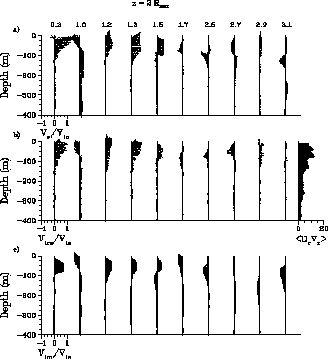
Figure 2: Vector stick plots at 2 Rmax in upper 400 m of a) residual (observed-geostrophic currents) profiles b) near-inertial (least square model including RMS differences), and c) simulated near-inertial current profiles for a four-mode baroclinic model. Residual, observed and simulated near-inertial currents were normalized by 1.07 m s-1 using Price scaling arguments. Time of each AXCP measurement is scaled in inertial wavelength (product of storm speed and local inertial period) period relative to hurricane Gilbert’s center on 16 Sept 1988 (from Shay et al. 1998).
OML Budgets: Central to the question of OHC changes and upper-ocean cooling is understanding the terms in the OML budgets, which consists of horizontal and vertical advection terms, surface heat fluxes and mixing parameterizations. In 1-dimensional treatments, the advection terms are neglected which results in a balance between surface heat fluxes (i.e. Qo) and vertical mixing (ht) processes. Vertical mixing processes can be further separated into two primary processes: 1) wind stress (or surface friction velocity-u*); and 2) vertical current shear across the base of the OML. The work done on the OML goes as the cube of the surface frictional velocity (u*3) whereas the current and the current shear scale as the square of the surface fictional velocity (u*2). However, vertical current shear is usually driven by near-inertial motions excited by a TC (Figure 2), and induces mixing between the OML and the thermocline by lowering the Richardson number to below criticality (Shay et al. 1992; Schade and Emanuel 1994). In the TC case, the shear-induced mixing process is 3-dimensional and causes the OML to cool and deepen, which modulates the SST (actually the OML temperature) response.
Using current and temperature profiles acquired in the 3-dimensional near-inertial wave wake excited by Hurricane Gilbert (1988), Jacob et al. (2000) and Jacob and Shay (2002) assessed these terms using various bulk OML treatments in diagnostic and numerical models. Current shear-induced mixing accounted for about 65% of the OML cooling within 4 Rmax of the track, whereas horizontal advection of thermal gradients by both the near-inertial and geostrophic currents contributed between 10 to 15% to the OML budgets (larger values near the WCR), and areal-averaged surface heat fluxes ranged between 10 to 30% depending on the location relative to the track. Of particular importance to the OML budgets was the advection by the currents and vertical current shears (i.e. entrainment heat flux), both of which affect the temperature in the OML and the OHC. These results underscore the importance of concurrent velocity and salinity measurements along with thermal profiles in understanding the ocean’s role on the OML budgets and the OHC variations.
In addition to current shear and surface frictional velocity, how the forcing at the surface is transferred vertically to the base of the OML is a problem analogous to the upward/downward transports and roll vorticies in the ABL. D’Asaro (2002) reported on recent float deployments in the path of Hurricane Dennis that indicate rapid vertical excursions from the surface to the OML base over time scales of less than one hour. As vertical velocities were 2 to 8 cm s-1, such rapid cycling may be associated with Langmuir cells in which the upward and downward velocities are concentrated in narrow zones. These cells are associated with surface current convergence in the downwind direction that induced a downwelling of surface water into the OML (Weller and Price 1988). The alignment of Langmuir cells and their cyclonically rotating helical paths are then organized in the cross-wind pattern as a series of surface current and divergence cells to form a larger circulation pattern. While the relative spatial scales of this circulation pattern are usually O(km), the scaling of such a circulation pattern may be considerably larger at least scaling with the radius of maximum winds. Theoretical studies have attributed Langmuir circulation pattern to: 1) Ekman instability, 2) wind-driven current shear, or 3) interaction of the orbital velocities associated with low-frequency surface waves and the wind-driven current shears. Given the time scales of less than an hour in the OML data acquired from the Hurricane Dennis floats (Figure 3), the candidate mechanism may be the interaction between orbital velocity and wind-driven current shears on these shorter time scales.
In this context, Lagrangian float measurements require the larger-scale shear profiles to help in their interpretation as well as the orbital velocity profiles associated with the low frequency surface waves measured by Airborne eXpendable Current Profilers (AXCP). If indeed vertical transports are primarily occurring in such narrow zones, the horizontal resolution of observations and ocean models must be over fine-scales to resolve these features. Given the paucity of concurrent float and AXCP observations during high wind and large heat flux conditions, developing such a parameterization will require such data sets.
Effects of Precipitation: Precipitation effects on the OML during TC passage has generally remained unresolved given the lack of Conductivity Temperature and Depth (CTDs) measurements during and subsequent to storm passage. Pudov and Petrichenko (2000) acquired CTD measurements in the wakes of several typhoons during the Spectrum 90 expeditions in the western North Pacific Ocean. Precipitation amounts estimated both from direct measurements and calculated from desalting of the ocean upper layer at a TC passage are rather high. For example, direct measurements at the station Dozhu gave 67 cm d-1 (Zhang 1993), and the amounts calculated over the ocean upper layer desalting after Typhoon Flo passed gave more than 39 cm over a 12 h period as shown in Figure 4. Notice that these net salinity decreases exceeded 0.3 psu during Typhoon Flo’s passage due to precipitation that extended to 80 to 90 m beneath the surface.
To map the salinity changes in the OML, Airborne eXpendable Conductivity Temperature and Depth (AXCTD) profilers were recently deployed in Hurricanes Isidore and Lili for the first time. These profiles provide a rapid means of estimating the temperature and salinity profiles during hurricanes from research aircraft over broad scales. The AXCTDs have accuracies of 0.05 practical salinity units (psu) and a resolution of +/- 0.03 psu to 1000 m at 1 m vertical scales. Recent comparisons with shipboard CTDs from the Eastern Pacific Investigation of Climate (EPIC) revealed that AXCTD measurements are within this envelope. Relating rain rates from satellite and aircraft-based measurements to the salinity variations would be useful in understanding the net effect of freshening the OML and its impact on the budgets.
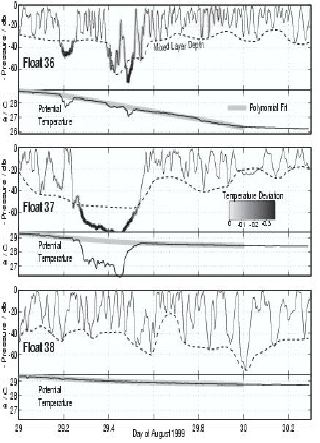
Figure 3: Lagrangian float measurements of trajectories (solid), mixed layer depths (dashed) and potential temperature acquired during the passage of hurricane Dennis in the western Atlantic basin in Aug 1999 for three floats where float 36 was located to the right of the track in the region of maximum cooling of 2.5 to 3oC (from D’Asaro 2002).
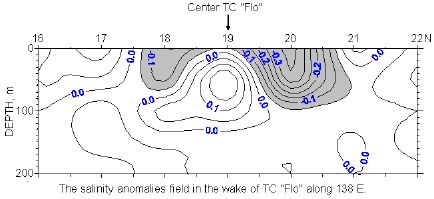
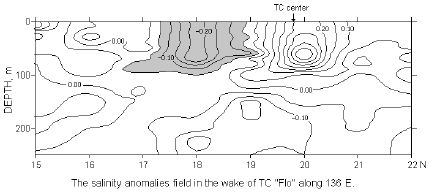
Figure 4: Salinity anomaly response (gray) to Typhoon Flo in the western North Pacific Ocean relative to the storm center along 138oE (upper panel) and 136oE (lower panel) due to the net Evaporation and Precipitation effect on the OML salinity budget. The anomalies are contoured at 0.05 psu and are based on a series of CTD measurements acquired as part of the Spectrum 90 experiments from Soviet Research vessels (from Pudov and Petrichenko 2000).
Mixing Parameterizations: From a series of recent numerical experiments using the Hybrid Community Ocean Model (HYCOM), Jacob et al. (2002) tested several ocean mixing schemes using the same initial conditions and atmospheric forcing from the Gilbert case (Figure 5). As several levels were within the OML, spatial and temporal OML evolution for the four turbulent kinetic energy (TKE) entrainment closure schemes were similar. However, significant differences were also found in the magnitude and areal extent of the response. In fact, surface heat flux differences were as large as 500 W m-2 compared to the Gaspar scheme. This result points to the relative importance of carefully testing these TKE schemes such as Mellor-Yamada (1982), K-Profile Parameterization (Large et al. 1994), and Price-Weller-Pinkel (1986) using high quality data sets acquired under TC conditions. Such sensitivity testing to evaluate model performance is imperative in accurately simulating the ocean response before an ocean model is even coupled to an atmospheric model.
1.4.3: Air-Sea Interface:
Sea Surface Processes: Recent composite analyses by Cione et al. (2000) of surface data compiled from 37 Atlantic basin hurricanes between 1975-1998 suggest that the sea-air contrast (i.e. SST minus surface air temperature) significantly increases well outside the region of strongest surface winds and is primarily a result of surface air temperature cooling (Fig. 6a). These observations show that most of the low-level cooling occurs far outside the region of strongest winds and horizontal pressure gradients and as a result adiabatic expansion of the inflowing air parcel only accounts for 16% of the cooling observed between 1.25 to 3.25o radii from the storm center (Fig. 6b). For the subset of observations that contained moisture measurements, surface specific humidity was also shown to decrease a considerable distance from the storm center (Fig. 6c). These observations suggest that the observed reduction in surface air temperature is not simply a result of near-surface evaporation from sea spray or precipitation. An alternate explanation, supported by earlier studies of TCs and rainbands, is that outside the inner core, unsaturated convective downdrafts may be transporting relatively dry, cool air into the near-surface environment.
Surface Wave Field: The passage of Hurricane Bonnie (1998) in the western Atlantic Ocean basin underscored the uncertainties in understanding the upper ocean mixed layer response in the presence of a strong wind and vigorous surface wave field (Wright et al. 2001). Central to these uncertainties is determining the role of strongly forced surface waves on the mixed layer cooling and deepening patterns particularly in the right-rear quadrant of the storm where strong current shears develop (Shay et al. 1992). On 24 August, an air-sea interaction experiment was conducted from the NOAA WP-3D aircraft where the mixed layer thermal structure was observed from a series of AXBTs along with concurrent observations of the directional wave spectra from the NASA Scanning Radar Altimeter (SRA).
From the Bonnie case, Wright et al. (2001) found a maximum Hs of 10.5 m in the front-right quadrant, with a strong gradient decreasing to 6 m in the left-rear quadrant, which is reflected in Figure 7. Over the domain, surface wave wavelengths ranged from 175 to 300 m, which represents a 10 to 14 s wave period based on linear theory. Notice that the directional wave spectra in the right-rear quadrant indicated a bimodal distribution with one component propagating towards about 330oT and a more energetic component moving at about 60oT. From these measurements, Wright et al. (2001) found a fairly complicated surface wave environment associated with Bonnie. The significant slope is the root mean square waveheight divided by the wavelength of the dominant wave. Huang (1981) showed the importance of significant slope relative to OML processes such as mixing efficiency and dissipation for higher frequency surface waves and breaking effects. As shown in Figure 8, the slope ranges from 0.02 to 0.05 where the maximum is located in the region of the 2.5oC cooling just in back of the eye (Cook et al. 2002). Furthermore, a secondary maximum is located in the right-front quadrant where Hs is a maximum of 10.5 m in that region. On the left side of the storm significant slopes are less than 0.02. The spatial variations of the slopes suggest a correlation to mixed layer depth changes of 40 to 50 m as a result of the mixing. Surface wave slopes warrant further investigations as a proxy for efficiencies of vertical mixing across the OML base (Huang 1981).
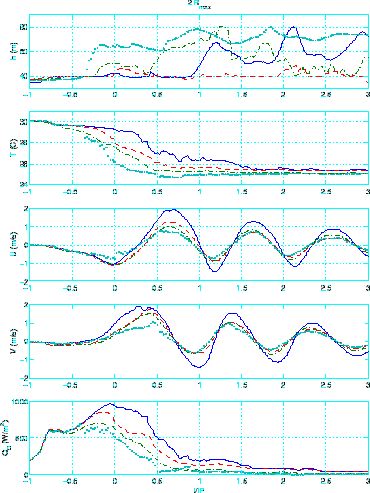
Figure 5: Comparison of simulated ocean mixed layer depth (h), temperature (T), east-west current (U), north-south current (V) and surface heat fluxes (Qo) time series (in IP) relative to the passage of Hurricane Gilbert using Gaspar (red), KPP (green), Mellor-Yamada (blue), and PWP(cyan) TKE closure schemes for the same forcing and initial ocean conditions from the Hybrid Community Ocean Model (courtesy of S. D. Jacob).
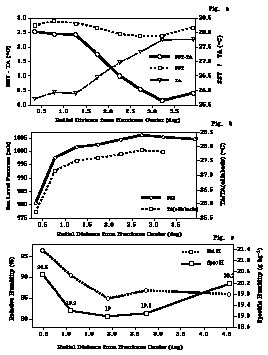
Fig. 6: a) Azimuthally-averaged values of SST-TA (solid line/open circles), SSTs (dashed line/open boxes) and TA (solid line/open triangles) as a function of radius; b) The radially-averaged, composite sea level pressure (SLP) (solid line/open circles) and TA due to adiabatic expansion (dashed line/open boxes) as a function of radius; and c) azimuthally-averaged, relative humidity (Rel H) (dashed line/open circles) and surface specific humidity (Spec H) (solid line/open boxes). SST/Ta SLP, Rel and Spec H are given in oC, mb, % and g kg-1, respectively.
An important aspect of this problem that is often overlooked is surface wave interactions with the 3-dimensional surface current field. Surface currents measured from Over-The-Horizon Radar (Georges et al. 1993) indicated regions of positive surface current vorticity in the right- front quadrant of Hurricane Bonnie where the maximum significant wave height was found slightly north of the OTHr domain. Surface currents ranged between 1.5 to 2 m s-1.. In regions of localized positive and negative near-surface surface current vorticities, the Hs may increase or decrease depending on the sign of the vorticity. In companion papers, Walsh et al. (1996) and Shay et al. (1996) found a caustic region (area of enhanced surface wave amplitudes associated with the swell) formed by the negative vorticity regime associated with a WCR located just north of the Gulf Stream during the ONR Surface Wave Dynamics Experiment. A series of ray tracing calculation was used to simulate the behavior of a 10 s surface wave crossing the Gulf Stream and encountering the WCR. Given the location of the maximum Hs in the right-front quadrant where strong wind-driven currents exist, surface wave current interactions should be explored from measurement and model perspectives that include radar-derived surface currents from OTHr and high frequency (HF) coastal surface current radars.
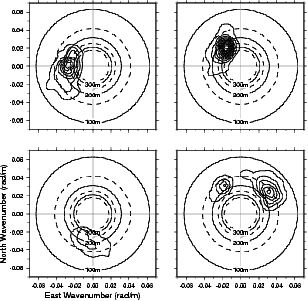
Figure 7: Directional wave spectra from the SRA during Hurricane Bonnie for the front-left and front-right quadrants (upper panels), and the rear-left and rear- right quadrants (lower panels). Concentric circles represent wavelengths of the low-frequency surface waves based on linear wave theory (from Wright et al. 2001).
Surface Winds: Surface winds in hurricanes have been estimated remotely using the Stepped-Frequency Microwave Radiometer (SFMR) from the NOAA WP-3D aircraft for the past 15 years (Uhlhorn and Black 2003). At six frequencies from 4.55 to 7.22 GHz, the SFMR measures radiative emissions, expressed in terms of brightness temperatures (Tb), from the ocean and the atmosphere. The percentage of foam coverage on the sea surface is known to increase monotonically with wind speed. At microwave frequencies, foam acts as a blackbody. Therefore, as foam increases, the ocean emits microwave energy more readily, and assuming a constant SST, the Tb increases. Given an accurate physical model that relates ocean surface wind speed and rainrate to measurements of Tb at several frequencies (Figure 9), a set of simultaneous equations may, in theory, be inverted to calculate the surface wind under practically all weather conditions.
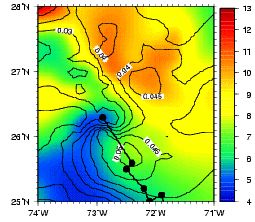
Figure 8: Significant wave height (m: color) and significant slope (nondimensional: contours) based on the directional wave spectra of Wright et al (2001) relative to storm position of Hurricane Bonnie at 26.2oN, 72.7oW (from Cook et al. 2002).
Since the use of the Global Positioning System (GPS) dropwindsonde system in hurricanes was first initiated in 1997 (Hock and Franklin 1998), co-located SFMR and GPS surface wind estimates have been made. During the 1998, 1999, and 2001 hurricane seasons, a total of 249 paired samples was acquired and compared. The SFMR equivalent 1-min mean, 10- m level neutral stability winds were found to be biased high by 2.3 m s-1 relative to the 10-m GPS-derived surface winds computed from an estimate of the mean boundary layer wind. Across the range of wind speeds from 10 to 60 m s-1, the RMS error was 3.3 m s-1. The bias was found to be dependent on storm quadrant, but was independent of wind speed, which suggests a possible relationship between microwave Tb and surface wave properties. Tests of retrieved wind sensitivities to SST, salinity, atmospheric thermodynamic variability, and surface wind direction indicate wind speed errors of less than 1 m s-1 above 15 m s-1.
Surface Drag Coefficients: Since the energy source for the TC is the ocean, knowledge of the heat and moisture fluxes through the interface and into the ABL are critical requirements. However, the exchange coefficients, for heat, moisture and momentum are not well known for the high wind speed and ocean surface wave conditions in hurricanes. The momentum transfer between the atmosphere and the ocean is characterized by the variation of wind with height and a surface drag coefficient that is a function of wind speed and surface roughness. However, no direct measurements have been acquired in TCs. Since 1997, several hundred GPS sondes have been deployed from research aircraft to measure the Lagrangian wind profiles in the ABL in TCs. As shown in Fig. 10, Powell et al. (2002) found a logarithmic variation of mean wind speed in the lowest 200 m, to a maximum at 500 m and a gradual weakening with height to 3 km. In these estimates, surface stress, roughness length and neutral stability drag coefficient determined by the profile method suggest a leveling of the surface momentum flux as winds increase above hurricane force and a slight decrease of the drag coefficient with increasing winds. This behavior contradicts the idea the surface flux parameterizations that are used in modeling applications of risk assessment, predictions of storm motion and intensity, surface waves and storm surge.
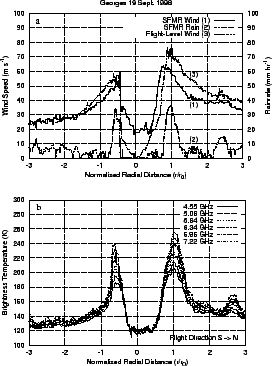
Figure 9: SFMR and flight-level wind speeds (m s-1) and SFMR rainrate (mm hr-1) (a) and Tb (b) as a function of normalized radial distance (r ro-1) from the center of Hurricane Georges, where ro=27 km is defined by the flight-level wind maximum in the north eyewall. Flight direction is south (left) to north (right). In (b), Notice that Tb generally increases with higher frequency SFMR channels (from Uhlhorn and Black 2002).
Alamaro et al. constructed an annular wind-wave flume and used it to estimate surface drag coefficient and the air-sea enthalpy fluxes for equivalent 10 m wind speeds up to 55 m s-1. As shown in Figure 11,the drag coefficient increases with wind speed but levels off at hurricane wind speeds. Notice that this point lies between 26 to 30 m s-1 at a cd at 3.6 to 3.9 x 10-3.
An indirect measure of the surface drag cofficient can be estimated using ocean current profiles acquired in hurricanes from AXCPs. Using measurements acquired during the passage of Hurricane Gilbert, Shay (2002) scaled the current profiles using the buoyancy frequency and estimated the vertical wavenumber spectra. For these scaled profiles, the observed kinetic energies were typically 4 to 10 times larger than the background internal wave spectral values where the ClockWise-rotating spectral energy densities exceeded the CCW-rotating densities by a factor of 4, which is consistent with the propagation of energy from a wind-forced OML into the thermocline. The corresponding downward vertical energy fluxes ranged from 0.5 to 10 ergs cm-2 s-1 where the average value was 2 ergs cm-2 s-1 which equaled those found in
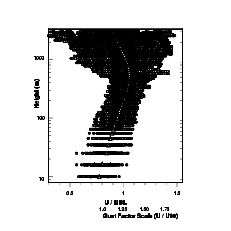
Figure 10: GPS sonde wind speed measurements normalized by the MBL speed (circles) and standard deviation (horizontal bars) for each height bin and an additional gust factor scale (from Powell et al. 2002).
Figure 11: Wind-speed dependent CD at 10 m from a wind-wave tank experiments over water depths of 14 cm for various heights of the false bottom (from Alamaro et al. (2002)).
oceanic fronts. Equating flight-level winds reduced to 10 m to the near-inertial energy flux suggested a nonlinear functional relationship
_(U10) =3.755 x 10-3 + tanh(-0.295/U102)
that is valid for winds up to 37 m s-1. Comparisons of this function to the drag coefficient based on wave-age (Donelan 1990) were favorable between wind speeds of 12 to 20 m s-1. As shown in Fig. 11, for wind speeds beyond 28 m s-1, this function leveled off to 3.755 x 10-3 in contrast to a monitonically increasing wind-speed dependent drag coefficient suggested by the WAMDI (1988). At low wind speeds, the analytical function agreed with those determined by Large and Pond (1981) and at the high wind speeds, the estimated surface drag coefficient agreed with that found by WAMDI (1988). Note the similarly in this nonlinear function and Cd in Figure 12 between 25 to 30 m s-1 based on the experiments from a wind-wave tank. Recent velocity profile measurements in Hurricanes Isidore and Lili will be used to test this approach since the surface winds fields were well resolved from the SFMR and GPS sonde profiles.
This wind regime is important for the air-sea coupling between the two fluids during strong winds associated with both tropical and extratropical storms. Consequently, a fundamental question remains with respect to the surface drag coefficient and it variations during strong wind and wave conditions.
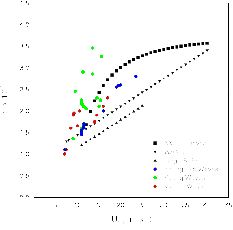
Figure 12: Wind-speed dependent surface drag coefficients based on Wamdi (1988), Large and Pond (1981), and Donelan (1990) wave-age parameterization relative to that function (_(U10)) derived from velocity profile measurements in Hurricane Gilbert (Shay 2002).
Enthalpy Coefficients: TC’s are driven by enthalpy fluxes (Figure 13) from the sea and limited mostly by surface drag, but there is little understanding of the dependence of these fluxes on wind at very high wind speeds. Direct measurements of the fluxes have been made at wind speeds as large as 25 m s-1, but technical problems have thus far prevented reliable estimates at higher speeds. Within the range in which good measurements exist, the drag coefficient increases with wind speed, owing to the increasing roughness of the sea surface, but there is little evidence for a corresponding increase in the enthalpy exchange coefficient . Numerical experiments together with potential intensity theory (e.g. Bister and Emanuel ) indicate that if these transfer functions continued to higher wind speeds, tropical cyclones could be of no more than marginal hurricane intensity. This suggests that another process, or processes, must become active at high wind speed.
Sea Spray: One candidate for enhancing the sea-air enthalpy flux at high wind speeds is sea spray. Laboratory studies (e.g. , numerical spray droplet models (e.g. , ) and open-ocean observations all show that sea spray can redistribute enthalpy between the temperature and humidity fields in the MBL.
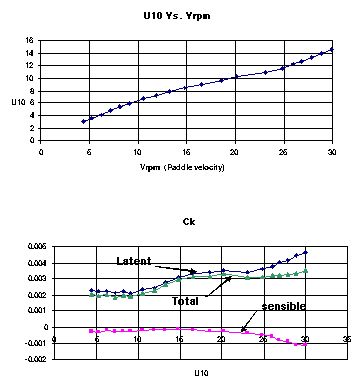
Figure 13: Dependence on 10 m wind speed of the exchange coefficients of enthalpy, latent heat, and sensible heat. The sensible heat exchange coeffficent last has been deduced as the difference between the total and the latent heat coefficients (provided by Kerry Emanuel).
Several parameterizations of sea spray (e.g. also showed little net enthalpy transfer, and numerical simulations of TCs showed little effect of spray on storm intensity. For example, Wang et al. (2001) examined the effects of sea spray on the ABL and the intensity of the TC using the Fairall et al. parameterization. The total enthalpy flux with sea spray evaporation increases by about 20% with a net contribution of less than 2% by the sea spray that causes only an 8% increase in TC intensity. This result contrasts the Andreas and DeCosmo (1999) sea spray parameterization where the same TC increased in intensity by about 25%.due to significant increases in both the sensible nd latent heat fluxes associated with the spray. In the inner core of the storm, a near-isothermal layer is formed which has not been substantiated by available observations. These feedbacks between the ocean surface and the lower part of the ABL warrant further attention and examination of parameterization schemes used in models to predict intensity change.
considered the effect of re-entrant sea spray. After a spray droplet is formed, only about 1% of its mass need evaporate to drop its temperature to the lowest possible value, the wet bulb temperature. If this droplet subsequently falls back into the sea, it cools the ocean and therefore must have effected a net enthalpy transfer to the atmosphere. The authors concluded that a large sea-air enthalpy transfer could result from re-entrant spray. , for the first time, considered spray effects on momentum transfer and concluded that this effect could be large as well. They developed a new parameterization of air-sea fluxes at high wind speed and showed that numerical simulations of hurricanes are very sensitive to the details of the parameterizations. Several other numerical simulations suggest that re-entrant sea spray may affect hurricane intensity. One inference that follows from the Andreas and Emanuel (2001) conclusion is that accurate TC intensity forecasting will not be possible without coupling the hurricane model to a detailed prognostic surface wave model. While this may prove to be the case, it contradicts other findings (e.g. Emanuel , who showed that many TCs can be hindcast using a simple coupled model with equal exchange coefficients for enthalpy and momentum.
Wind-wave coupling: The production of sea spray droplets in wind-driven seas is believed to be closely linked to the wave breaking process. The breaking zones destabilize the water surface, which greatly enhances the entrainment into the airstream of water droplets and spray by the surface winds. The extent of wave breaking activity in the extreme sea states accompanying hurricanes is not well known, but modern measurement technologies such as the NASA SRA have been deployed successfully to make detailed measurements of the dominant waves (e.g. Wright et al. 2001). The feasibility of gathering co-located whitecap imagery makes possible the estimation of the wave breaking probability as part of the ONR CBLAST hurricane field program.
Recently Banner et al. (2000) investigated ocean wave breaking probability where they proposed a strong threshold correlation between the significant wave steepness and the breaking probability. The associated winds covered a wide range, reaching gale force strength. It would be very interesting to investigate whether this relationship extends into the hurricane wind speed range. Such information could provide a more reliable basis for many fundamental air-sea interaction processes including more realistic estimates of the sea surface drag coefficient during TC conditions. Eventually, such an approach should provide for a more fundamental basis for parameterizing the spray/droplet source strength function than just wind speed.
Ocean surface waves may be “fetched-limited” in those areas in which the wind direction is changing rapidly as the TC passes a point. However, a region to the right of the storm path may experience larger surface wave heights if the storm translation speed matches the gravity wave speed so that strong forcing persists for some time. One possibility is that wind, wind stress, near-surface currents and wave directions in the rear quadrant of the TC are not necessarily aligned which may cause steeper wave slopes that are more effective in generating turbulent mixing in the ocean, and thus more rapid SST changes. Yet another important factor may be associated with wave-wave interactions. Inadequate data have been available to resolve the differences. It is also emphasized that the present models do not resolve the higher frequency waves (less than 10 m wavelengths) that are involved in wave breaking, and thus in the sea spray generation discussed above.
Boundary Layer Jets: Observed vertical wind profiles in the boundary layer of TCs often show a wind speed maximum between a few hundred meters and 1.5 km. The recent advent and extensive operational use of the GPS sonde (Hock and Franklin 1999) has shown that this feature is very common. Kepert (2001) and Kepert and Wang (2001) presented 3-dimensional analytical and numerical models, respectively, of the hurricane boundary layer. These models correctly reproduce some well-known features of the TC boundary layer (TCBL) wind field, such as the motion-induced asymmetry in the near-surface winds. They also show that a supergradient wind maximum exists in the upper part of the boundary layer, and analyze the dynamics that produce it. In brief, the jet is generated through the advection and conservation of angular momentum in the strong frictionally forced inflow. Inflow is maintained in the presence of supergradient flow, against the outward acceleration due to gradient adjustment, by the upward advection and diffusion of inwards momentum. In a moving storm, the asymmetric surface friction generates a frictionally modified wave-number one inertia wave. The vertical phase rotation and decay of this wave is such that diffusive processes eliminate its phase propagation, and gives a slowly decaying, anticyclonic rotation of the wave with height. The effect is that the jet is strongest to the left (right) front of the storm in the Northern (Southern) Hemisphere. Also, the surface wind factor (SWF; the ratio of near-surface to gradient wind speed) increases towards the storm’s center, and is larger on the left (right) in the NH (SH).
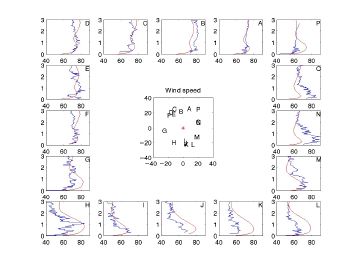
Figure 14: Outer panels: Hurricane Georges observed (rough) and modeled (smooth) profiles of wind speed (m s-1), with heights in kilometers. Center panel: observation locations, relative to storm track ( from Kepert (2001)).
Franklin et al (2002) analyzed SWF data derived from several hundred dropsonde wind profiles in tropical cyclones with results consistent with the models described above. Kepert (2002) found similar results in case studies of Hurricanes Andrew and Georges, and confirmed that the flow within the upper boundary layer of Hurricane Mitch was supergradient by up to 10 m s-1. Figure 14 shows wind speed profiles in and near the eyewall of Hurricane Georges from 1800 UTC 19 Sept to 0100 UTC 20 Sept. 1988, together with their storm-relative position. During this period, radar and 85 GHz SSM/I data both show that the core of Georges was highly symmetric, with a closed eye-wall with embedded reflectivity maxima generally to the left front and right rear. It is also clear that, while there is wide variation in profile shape, this variation has a systematic azimuthal structure, with the jet being more marked and lower to the left and rear of the storm, and less marked and higher to the right, consistent with the models. Modeled wind speed profiles, from the model of Kepert and Wang (2001), are also included in the figure, which successfully capture the bulk of the large-scale structure in the observations.
1.4.4: Summary
There has been significant progress in improving our understanding of the basic oceanic and atmospheric processes that occur during the passage of TCs. Central to these assertions is the need to isolate fundamental physical processes involved in the interactions through detailed process studies using experimental, empirical, theoretical and numerical approaches. As has been found from previous sets of measurements (Gilbert, Spectrum 90, etc), these approaches are needed to improve predictions of storm intensity and structure.
One of the interesting topical areas is the relationship between the coupled fields such as wave breaking and the generation of sea spray and how this is linked to localized air-sea fluxes. A key element of this is the atmospheric response to the oceanic forcing where there seems to a contrast of viewpoints. One argument is that the air-sea interactions are occurring over surface wave (wind-wave) time and space scales. Indeed some of the wind-wave tank and numerical studies suggest that these submesoscale phenomena may be quite important to the rate of air-sea transfers across the interface.
By contrast, there is also considerable ocean-atmosphere variability occurring over the storm scales that has a fundamental length scaling over the radius of maximum winds and another scale that includes the radius to gale force winds. Here, the fundamental science question is how are the two fluids coupled through OML and ABL processes, and what is the fundamental time scale of interactions. These questions are not easily answered as it is clear that there must be interactions occurring over various time/space scales. It is clear that while it is the eyewall where intense air-sea interactions occur (i.e. bulk aerodynamic formulae), enthalpy fluxes may either be an integrated effect over larger scales (a trajectory time scale) or instantaneous just at the radii of maximum winds. Clearly, there are several time scales that are apparent in the oceanic response that span time scales of seconds, minutes, hours that can persist for days to weeks. Process studies need to begin to look at these multiple scale aspects associated with the atmospheric response.
With regard to the oceanic response to the atmospheric forcing, an important missing ingredient in many studies is the role of the forced and background current fields. In addition to aircraft-based sampling from AXCPs and AXCTDs, there are new efforts along the southeastern United States that are underway to being to deploy long-range, HF-radars to map the surface currents to 200 km from the coast. Such measurements would not only be invaluable to map the wind-driven surface currents during high winds, but also in the case of phased arrays, map the directional wave spectra over the domain.These measurements could then be used for not only examining air-sea interactions, but assessing the relative importance of surface wave current interactions under strong wind conditions.
1.4.5 Recommendations
Specific Recommendations are:
Bibliography
Alamaro, M., K. Emanuel, J. Cotton, W. McGillis, and J. Edson, 2002: Experimental investigation of air-sea transfer of momentum and enthalpy at high wind speed. In Proceedings of the 25th Conference on Hurricanes and Tropical Meteorology, American Meteorological Society, Boston, MA, 667-668.
Andreas, E. L., and J. DeCosmo, 1999: Sea spray production and influence on air-sea heat and moisture fluxes over the open ocean. In Air-Sea Exchange Physics, Chemistry and Dynamics,G. L. Geernaert, Ed., Kluwer, 327-362.
Andreas, E. L. and K. Emanuel, 2001: Effects of sea spray on tropical cyclone intensity. J.Atmos. Sci., 58, 3741-3751.
Andreas, E. L. and K. A. Emanuel, 1999: Effects of sea spray on tropical cyclone intensity. Preprint volume, 23rd Conf. on Hurricanes and Tropical Meteorology, American Meteorological Society, Boston, MA, 22-25.
Banner, M.L., Babanin, A.V. and Young, I.R. 2000: Breaking Probability for Dominant Waves on the Sea Surface. J. Phys. Oceanogr., 30, 3145-3160.
Bao, J.-W., J. M. Wilczak, J. K. Choi and L. H. Kantha, 2000: Numerical simulations of air-sea interaction under high wind conditions using a coupled model: A study of hurricane development. Mon. Wea. Rev., 128, 2190-2210.
Bosart, L., C. S. Veldon, W. E. Bracken, J. Molinari, and P. G. Black, 2000: Environmental influences on the rapid intensification of hurricane Opal (1995) over the Gulf of Mexico. Mon Wea. Rev., 128,322-352.
Bister, M. and K. A. Emanuel, 1998: Dissipative heating and hurricane intensity. Meteor.Atmos. Physics, 50, 233-240.
Chang. S. W., and R. A. Anthes, 1978: Numerical simulations of the ocean’s nonlinear baroclinic response to translating hurricanes. J. Phys. Oceanogr., 8, 468-480.
Cione, J.J., P. G.. Black and S. Houston, 2000: Surface observations in the hurricane environment. Mon. Wea. Rev., 128, 1550-1561.
Cook, T. M., L. K. Shay, S. D. Jacob, C. W. Wright, P. G. Black, E. Uhlhorn, 2002: Surface wave effects on the ocean mixed layer response to Hurricane Bonnie. In Proceedings of the 25th Conference on Hurricanes and Tropical Meteorology, American Meteorological Society, Boston, MA, 633-634.
D’Asaro, E. A., 2002: The ocean boundary layer underneath Hurricane Dennis. J. Phys. Oceanogr., (In Press).
DeMaria, M., and J. Kaplan, 1999: An updated Statistical Hurricne Intensity Prediction Scheme (SHIPS) for the Atlantic and Eastern Pacific basins. Wea. Forecast., 14, 326-337.
Donelan, M.A., 1990: Air-Sea Interaction. The Sea: Ocean Engineering Series, 9, John Wiley and Sons Publishing Company, New York, 239-292.
Edson, J. B., S. Anquentin, P. G. Mestayer and J. F. Sini, 1996: Spray droplet modeling: 2.An interactive Eulerian-Lagrangian model of evaporating spray droplets. J. Geophys. Res.,101, 1279-1293.
Emanuel, K. A., 1988: The maximum intensity of hurricanes. J. Atmos. Sci., 45, 1143-1155.
Emanuel, K., 2002: A similarity hypothesis for air-sea exchange at extreme wind speeds. J.Atmos. Sci., (Submitted)
Emanuel, K. A., 1999: Thermodynamic control of hurricane intensity. Nature, 401, 665-669.
Fairall, C. W., J. D. Kepert and G. J. Holland, 1994: The effect of sea spray on surface energy transports over the ocean. Global Atmos. Ocean Sys., 2, 121-142.
Gaspar, P., 1988: Modeling the seasonal cycle of the upper ocean. J. Phys. Oceanogr., 18, 161-180.
Geerneart, G. L., S. E. Larsen and F. Hansen, 1987: Measurements of the wind stress, heat flux and turbulence intensity during storm conditions over the North Sea. J. Geophys. Res., 92,13127-13139.
Georges, T., J. A. Harlan, L. R. Meyer, and R. G. Peer, 1993: Tracking Hurricane Claudette with the US Air Force Over-The-Horizon radar. J. Atmos. Oceanogr. Tech.,10(4), 441-451.
Hock, T. J., and J. L. Franklin, 1999: The NCAR GPS dropwindsonde. Bull Amer Met. Soc., 80, 407-420.
Huang, N. E., 1981: An estimate of the influence of breaking waves on the dynamics of the upper ocean. In Wave Dynamics and Radio Probing of the Ocean Surface, eds O. W. Phillips and K. Hasselmann, Plenum Press, London, UK, 295-312.
Jacob, D. S., L. K. Shay, A. J. Mariano, and P. G. Black, 2000: The three-dimensional mixed layer heat balance during hurricane Gilbert. J. Phys. Oceanogr., 30, 1407-1429.
Jacob, L. K., and L.K. Shay, 2002: The role of oceanic mesoscale features on the tropical cyclone-induced response. J. Phys. Oceanogr. (In Press)
Jacob, S. D., L. K. Shay, and G. Halliwell, 2002: Effects of entrainment closure on the oceanic mixed layer response during a tropical cyclone passage: A numerical investigation. In Proceedings of the 25th Conference on Hurricanes and Tropical Meteorology, American Meteorological Society, Boston, MA, 660-661.
Kepert, J. D., C. W. Fairall and J.-W. Bao, 1999: Modelling the interaction between the atmospheric boundary layer and evaporating sea spray droplets. In Air-Sea Exchange: Physics, Chemistry and Dynamics. G. L. Geernaert, Ed, Kluwer, 369-409.
Kepert, J., 2001: The dynamics of boundary layer jets within the tropical cyclone core. Part I: linear theory. J. Atmos. Sci., 58, 2469-2484.
Kepert, J. and Y. Wang, 2001: The dynamics of boundary layer jets within the tropical cyclone core. Part II: Nonlinear enhancement. J. Atmos. Sci., 58, 2485-2501.
Korolev, V. S., S. A. Petrichenko and V. D. Pudov, 1990: Heat and moisture exchange between the ocean and atmosphere in tropical storms Tess and Skip. Sov. Meteor. Hydro., 3, 92-94.
Large, W., and S. Pond, 1981: Open ocean momentum flux measurements in moderate to strong winds. J. Phys. Oceanogr., 11, 324-336.
Large, W., S., J. C. McWilliams, and S. C. Doney, 1994: Oceanic vertical mixing areview and a model with nonlocal boundary layer parameterization. Rev. Geophys., 32,363-403.
Mainelli, M. M., M. DeMaria, and L. K. Shay, 2002: The impact of oceanic heat content on hurricane intensity forecasts using the SHIPS model. . In Proceedings of the 25th Conference on Hurricanes and Tropical Meteorology, American Meteorological Society, Boston, MA, 627-628.
Mainelli, M. M., and L. K. Shay, 2002: Effects of the upper ocean heat potential on tropical cyclone intensity change, Mon. Wea. Rev. (In preparation).
Mestayer, P. G. and C. Lefauconnier, 1988: Spray droplet generation, transport, and evaporation in a wind wave tunnel during the Humidity Exchange over the Sea Experiments in the Simulation Tunnel. J. Geophys. Res., 93, 572-586.
Marks, F. M., L. K. Shay, and PDT-5, 1998: Landfalling tropical cyclones: Forecast problems and associated research opportunities. Bull. Amer. Meteor. Soc., 79, 305-323.
Mellor, G. L., and T. Yamada, 1982: Development of a turbulence closure model for geophysical fluid problems. Rev. Geophys. and Space Phys., 20(4), 851-875.
Powell, M., P. J. Vickery, and T. A. Reinhold, 2002: Boundary layer wind profiles and drag coefficient behavior in tropical cyclones. Geophys. Res. Letters (submitted).
Price, J. F., R. A. Weller, and R. Pinkel, 1986: Diurnal cycling; observations and models of the upper ocean response to diurnal heating, cooling and wind-mixing. J. Geophys. Res., 7. 8411-8427.
Pudov, V., and S. Petrichenko, 2000: Trail of a typhoon in the salinity field of the ocean upper layer. Atmospheric and Ocean Physics (Izvestiya Acad. Sci.), 36, 700-706.
Rouault, M. P., P. G. Mestayer and R. Schiestel, 1991: A model of evaporating spray droplet dispersion. J. Geophys. Res., 96, 7181-7200
Schade, L. R., and K. A. Emanuel, 1999: The ocean’s effect on the intensity of tropical cyclones: Results from a simple coupled atmosphere-ocean model. J. Atmos. Sci., 56, 642-651.
Shay, L. K., 2002: Near-inertial wave energy fluxes during hurricane Gilbert, J. Phys.Oceanogr., (In Revision).
Shay, L. K., P. G. Black, A. J. Mariano, J. D. Hawkins, and R. L. Elsberry, 1992: Upper ocean response to hurricane Gilbert. J. Geophys. Res., 97, 20,227-20,248.
Shay, L.K., P.C. Zhang, H.C. Graber and E.J. Walsh, 1996: Simulated surface wave current interactions during SWADE. The Global Atmosphere-Ocean System, 5(2), 125 - 151.
Shay, L.K., A.J. Mariano, S.D. Jacob, and E.H. Ryan, 1998: Mean and near-inertial ocean current response to hurricane Gilbert. J. Phys. Oceanogr., 28, 858 - 889.
Shay, L.K., G.J. Goni and P.G. Black, 2000: Effects of a warm ocean feature on Hurricane Opal. Mon. Wea. Rev., 128, 1366-1383.
Uhlhorn, E. W. and P. G. Black, 2002: Verification of remotely sensed sea surface winds in hurricanes, J. Atmos. Ocean. Tech, (in press).
Walsh, E. J., L. K. Shay, H. C. Graber, A. Guillaume, D. Vandemark, D. E. Hines, R. N. Swift, and J. F. Scott, 1996: Observations of surface-wave current interaction during SWADE.
Global Atmos. Ocean Syst., 5, 99-124.
WAMDI Group, 1988: The WAM model-a third generation ocean wave prediction model. J. Phys. Oceanogr., 18, 1775-1810.
WMO, 1998:Topic chairman and rapporteur reports of the fourth WMO International Workshop on tropical cyclones (IWTC-IV), Haikou, China, 21-30 April 1998. Tropical Meteorology Research Programme Report No. 59, WMO, Geneva Switzerland.
Wright, C. W., E. J. Walsh, D. Vandemark, W. B. Krabill, A. W. Garcia, S. Houston, M. Powell, P. Black, and F. D. Marks, 2001: Hurricane directional wave spectrum spatial variations in the open ocean. J. Phys. Oceanogr., 31, 2472-2488.
Zhang Y. 1993: Torrential rains in tropical cyclones. In Tropical Cyclone Disasters, Peking University, Beijing, China, 474 - 485.